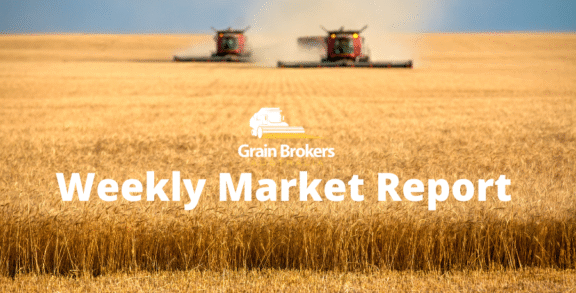
Spring has arrived in the northern hemisphere, and the winter crops are entering a critical phase in their production cycle. Lack of rain in the forecast and soil moisture retreating in key parts of Europe and the Black Sea remains a growing concern for global production as crops emerge from their winter hibernation.
Much of the European continent has received below-average rainfall in the last four weeks. The trade is keeping a keen eye on the forecasts and, more importantly, actual rainfall registrations, as yield reductions will result if beneficial rain is not received before the end of April.
This is a stark contrast to the planting period where wet weather hampered fieldwork and led to a substantial decrease in the planted area across parts of the European Union compared to last year. As a result, 2020/21 wheat production across the 27 member states and Britain is forecast to fall around 6 per cent to 145 million metric tonne.
There are regions which have remained wet, and they will benefit from the dryer and warmer than normal conditions. However, this area is small compared to the area which will suffer if the lack of precipitation pushes the cereal and canola crops into stress. The dryness may have assisted the spring wheat planting program, but the situation is more critical for the freshly emerging plants as they do not have a developed root system to access the limited soil moisture.
In France, the agriculture ministry estimated that the country’s soft wheat area would decrease by 7.5 per cent from last year to a 17-year low of 4.6 million hectares due to wet weather at sowing. In contrast, the ministry put the estimated barley area up 2.8 per cent to 2.0 million hectares.
According to FranceAgriMer, 62 per cent of the French soft wheat crop was rated good or excellent at the end of March, compared with 84 per cent at the same time last year. This is down 1 per cent week-on-week.
Germany’s 2020 wheat harvest is forecast at around 23 million metric tonne. This is unchanged from 2019 thanks to higher yield projections that are expected to offset a 6 per cent fall in the planted area to 2.9 million hectares. A mild winter in Germany has boosted winter wheat prospects, and recent dry weather helped spring wheat sowing, but rainfall is needed in the next three weeks to see the potential of both crops maintained.
Most parts of Poland urgently require rain to maintain favourable crop conditions. Poland’s 2020 wheat crop is estimated at 11.5 million metric tonnes, an increase of 4 per cent on last year. However, this forecast is subject to downward revision if it stays dry for the remainder of the month.
The area sown to wheat in Britain is forecast to be sharply lower this season due to excessive rain in the autumn and winter. This disrupted the winter planting program and hampered crop development due to prolonged periods of waterlogging. Crops have died in some areas as a result of the inundation.
The additional spring wheat seedings are only expected to partially compensate for the lost area. Accordingly, the total area planted to wheat in Britain for the 2020/21 campaign is likely to fall by 17 per cent to 1.5 million hectares. The winter wheat crop was rated 49 per cent good to excellent, with 6 per cent failing to emerge. The winter barley crop is in a similar condition with 45 per cent rated good to excellent.
The dry weather continues in parts of Russia and Ukraine and is starting to be reflected in production forecasts for the region. Several agencies have decreased their Russian production estimates slightly but are still saying that it is too early to make any drastic cuts. If the situation continues for another three weeks, the story will be vastly different.
Production in Ukraine is already expected to be lower than last year due to a reduction in the planted area and lack of winter rainfall. According to the Ukrainian grain traders’ union, winter wheat production is estimated at 25.8 million metric tonne, compared to 28.2 million metric tonne last year.
Across the Atlantic, the United States Department of Agriculture released its first weekly crop progress report for the season, and it was better than the pundits had expected. The winter wheat crop was pegged at 62 per cent good to excellent, the best early April crop rating since 2010. This is up from 60 per cent this time last year and compares favourably with the five year average of 49 per cent.
The biggest concern for crops on both sides of the Atlantic is a sudden cold snap. In many regions, the crops have emerged from winter dormancy earlier than usual, and development is well advanced compared to the average for this stage of the season. This makes the crops at critical growth stages very vulnerable to sub-zero temperatures.
The dry weather outlook in Europe in conjunction with prolonged old crop wheat demand driven by the COVID-19 pandemic is providing sustained support for old crop and new crop grain prices, particularly wheat. Many consumers are placing a greater emphasis on nearby supply over price while fears of supply chain disruption persist. This is despite a significant market inverse and the new crop black Sea harvest being only three months away.
Countries like Egypt have announced that they will be purchasing up to an additional 800,000 metric tonne of wheat during their harvest period which commences this month. This is quite an unusual move as Egypt does not normally import wheat during their local harvest. This will increase strategic reserves to as much as eight months of cover.
Romania, the European Union’s second-biggest wheat exporter, has become the first country to ban grain exports during the coronavirus pandemic. The government has decided to prohibit exports of wheat, corn, rice, sunflower and other grains to countries outside the European Union for as long as the COVID-19 state of emergency is in force.
These decisions are a sign that both major importers and major exporters are becoming fearful of supply in the current environment. While these actions alone will not have a material impact on global supply and grain prices, an escalation of such moves could distort traditional trade pathways and push grain prices higher. Any weather-driven production issues will no doubt exacerbate such price responses.
Call your local Grain Brokers Australia representative on 1300 946 544 to discuss your grain marketing needs.





